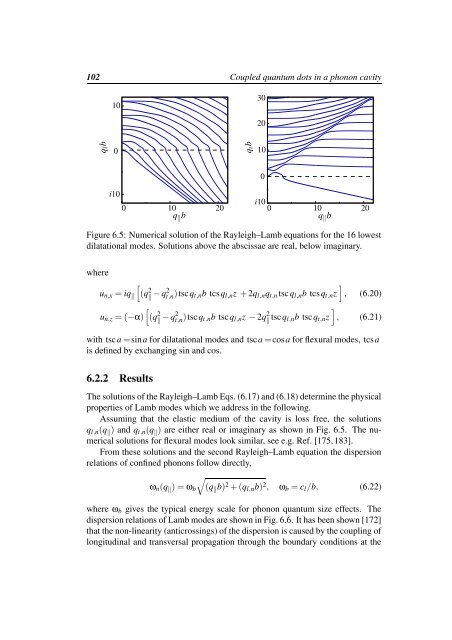Spin-orbit coupling and electron-phonon scattering - Fachbereich ...
Spin-orbit coupling and electron-phonon scattering - Fachbereich ...
Spin-orbit coupling and electron-phonon scattering - Fachbereich ...
Create successful ePaper yourself
Turn your PDF publications into a flip-book with our unique Google optimized e-Paper software.
102 Coupled quantum dots in a <strong>phonon</strong> cavity<br />
10<br />
30<br />
PSfrag replacements<br />
20<br />
qlb<br />
0<br />
qtb<br />
10<br />
0<br />
i10<br />
i10<br />
0 10 20<br />
0<br />
10<br />
q ‖ b<br />
q ‖ b<br />
20<br />
Figure 6.5: Numerical solution of the Rayleigh–Lamb equations for the 16 lowest<br />
dilatational modes. Solutions above the abscissae are real, below imaginary.<br />
where<br />
u n,x = iq ‖<br />
[(q 2 ‖ − q2 t.n)tscq t,n b tcsq l,n z + 2q l,n q t,n tscq l,n b tcsq t,n z<br />
]<br />
, (6.20)<br />
[<br />
]<br />
u n,z = (−α) (q 2 ‖ − q2 t,n)tscq t,n b tscq l,n z − 2q 2 ‖ tscq l,nb tscq t,n z , (6.21)<br />
with tsca =sina for dilatational modes <strong>and</strong> tsca =cosa for flexural modes, tcsa<br />
is defined by exchanging sin <strong>and</strong> cos.<br />
6.2.2 Results<br />
The solutions of the Rayleigh–Lamb Eqs. (6.17) <strong>and</strong> (6.18) determine the physical<br />
properties of Lamb modes which we address in the following.<br />
Assuming that the elastic medium of the cavity is loss free, the solutions<br />
q l,n (q ‖ ) <strong>and</strong> q t,n (q ‖ ) are either real or imaginary as shown in Fig. 6.5. The numerical<br />
solutions for flexural modes look similar, see e.g. Ref. [175, 183].<br />
From these solutions <strong>and</strong> the second Rayleigh–Lamb equation the dispersion<br />
relations of confined <strong>phonon</strong>s follow directly,<br />
ω n (q ‖ ) = ω b<br />
√(q ‖ b) 2 + (q l,n b) 2 , ω b = c l /b, (6.22)<br />
where ω b gives the typical energy scale for <strong>phonon</strong> quantum size effects. The<br />
dispersion relations of Lamb modes are shown in Fig. 6.6. It has been shown [172]<br />
that the non-linearity (anticrossings) of the dispersion is caused by the <strong>coupling</strong> of<br />
longitudinal <strong>and</strong> transversal propagation through the boundary conditions at the
















